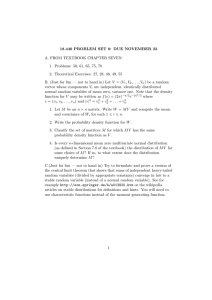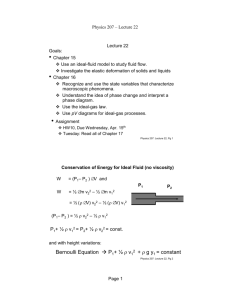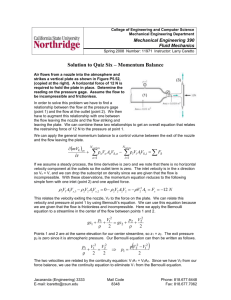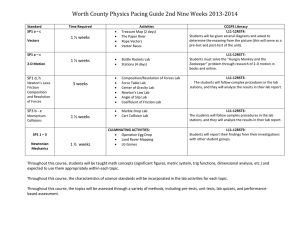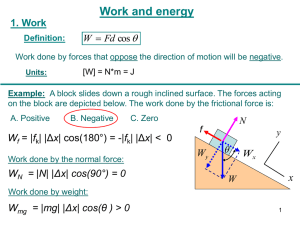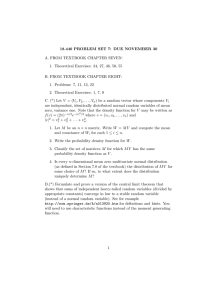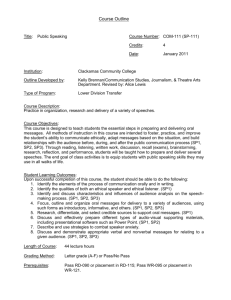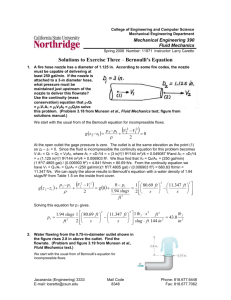Math 317: Linear Algebra HW 1 Solutions Fall 2015
advertisement
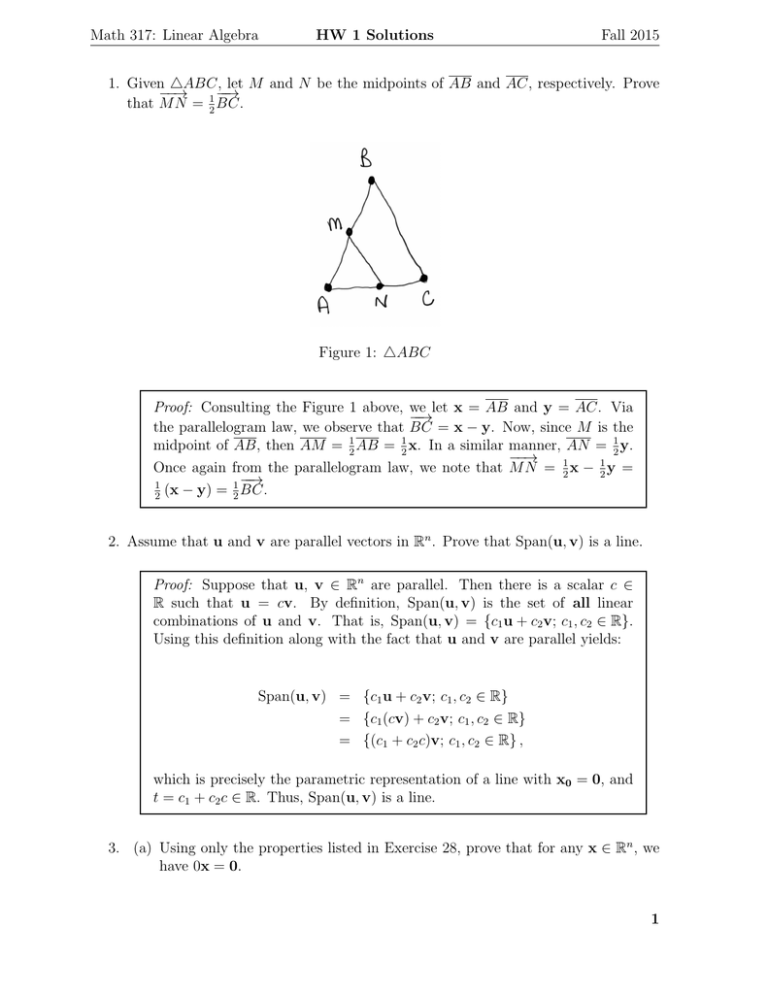
Math 317: Linear Algebra
HW 1 Solutions
Fall 2015
1. Given 4ABC, let M and N be the midpoints of AB and AC, respectively. Prove
−−→
−−→
that M N = 12 BC.
Figure 1: 4ABC
Proof: Consulting the Figure 1 above, we let x = AB and y = AC. Via
−−→
the parallelogram law, we observe that BC = x − y. Now, since M is the
midpoint of AB, then AM = 12 AB = 12 x. In a similar manner, AN = 21 y.
−−→
Once again from the parallelogram law, we note that M N = 21 x − 12 y =
−−→
1
(x − y) = 12 BC.
2
2. Assume that u and v are parallel vectors in Rn . Prove that Span(u, v) is a line.
Proof: Suppose that u, v ∈ Rn are parallel. Then there is a scalar c ∈
R such that u = cv. By definition, Span(u, v) is the set of all linear
combinations of u and v. That is, Span(u, v) = {c1 u + c2 v; c1 , c2 ∈ R}.
Using this definition along with the fact that u and v are parallel yields:
Span(u, v) = {c1 u + c2 v; c1 , c2 ∈ R}
= {c1 (cv) + c2 v; c1 , c2 ∈ R}
= {(c1 + c2 c)v; c1 , c2 ∈ R} ,
which is precisely the parametric representation of a line with x0 = 0, and
t = c1 + c2 c ∈ R. Thus, Span(u, v) is a line.
3. (a) Using only the properties listed in Exercise 28, prove that for any x ∈ Rn , we
have 0x = 0.
1
Math 317: Linear Algebra
HW 1 Solutions
Fall 2015
Proof: We begin by observing that by 28(c) (applying this both for the
scalar 0 and the vector 0) we have that 0x = (0 + 0) x and 0x+0 = 0x.
By the distributive property (i.e. 28g), we note that 0x = (0 + 0) x =
0x + 0x. We see that we have two different representations for 0x and
thus we may equate them to obtain: 0x + 0 = 0x + 0x. Now, by
28d, 0x has an additive inverse, that is, there is a term, call it −0x
such that 0x + (−0x) = 0. Using the associativity property in 28b to
reorder terms, we obtain: (−0x + 0x) + 0 = (−0x + 0x) + 0x which
then gives (using 28c) 0x = 0.
(b) Using the result of part a, prove that (−1)x = −x.
Proof: We begin by noting that −x is the element such that x+(−x) =
0. Thus, we begin by proving that x + (−1x) = 0. Using 28h and
28f, we obtain x + (−1x) = 1x + (−1x) = (1 − 1) x = 0x = 0, where
the last equation is true from part (a) of this exercise. Using 28c,
28d and the associativity property in 28b to reorder terms, we obtain
(−x+x)+(−x) = (−x+x)+−1x =⇒ 0−x = 0−1x =⇒ −x = −1x.
4. Starting with the vectors a = (a1 , a2 ) and b = (b1 , b2 ), draw a triangle (in Quadrant
I) whose sides are the magnitude of a and b. Write the third side of the triangle in
terms of a and b. Let φ be the angle opposite of the side of the triangle that you
have written in terms of a and b. The law of cosines asserts that
c2 = kak2 + kbk2 − 2kakkbk cos φ,
(1)
where c is the third side of the triangle that you have written in terms of a and b.
Using (1) and the geometric form of the definition of dot product, show that
a · b = a1 b 1 + a2 b 2
(2)
Proof : Using the parallelogram law for the triangle given above in Figure
2, we find that c = ka − bk and thus from the law of cosines we have that
ka − bk2 = kak2 + kbk2 − 2kakkbk cos φ,
(3)
where φ is the angle between vectors a and b. Now a − b = (a1 − b1 , a2 − b2 )
if a = (a1 , a2 ) and b = (b1 , b2 ). Thus, by definition of the magnitude of a
vector, we have that ka − bk2 = (a1 − b1 )2 + (a2 − b2 )2 = a21 − 2a1 b1 + b21 +
a22 − 2a2 b2 + b22 . By the geometric definition of the dot product, we have that
2
Math 317: Linear Algebra
HW 1 Solutions
Fall 2015
Figure 2: Labelled Triangle
kakkbk cos φ = a·b, and thus (using the fact that kak2 = a21 +a22 and kbk2 =
b21 +b22 ), we find that kak2 +kbk2 −2kakkbk cos φ = a21 +a22 +b21 +b22 −2(a·b).
Thus we can rewrite (3) as
a21 − 2a1 b1 + b21 + a22 − 2a2 b2 + b22 = a21 + a22 + b21 + b22 − 2(a · b),
(4)
which simplifies precisely to
a · b = a1 b 1 + a2 b 2 .
5. Prove the triangle inequality: For any vectors x, y ∈ Rn , kx + yk ≤ kxk + kyk.
Scratch work : Before I prove this claim, I need to do some scratch work to determine
where I should begin in my proof. Following the hint, we may compute kx + yk2
using a proposition proved in class to obtain:
kx + yk2 = kxk2 + 2(x · y) + kyk2 .
Similarly, we can square the right hand side of the triangle inequality to obtain
(kxk + kyk)2 = kxk2 + 2kxkkyk + kyk2 .
Now, if the triangle inequality were true, then kx+yk ≤ kxk+kyk =⇒ kx+yk2 ≤
(kxk + kyk)2 =⇒ kxk2 + 2(x · y) + kyk2 ≤ kxk2 + 2kxkkyk + kyk2 =⇒ x · y ≤
kxkkyk. The last inequality is exactly the CS (or CBS) inequality that we proved
in class. Thus my scratch seems to suggest that if I start off with the CS inequality,
which I know is true, I should be able to deduce the triangle inequality.
3
Math 317: Linear Algebra
HW 1 Solutions
Fall 2015
Proof: Suppose that x, y ∈ Rn . By the CS (or CBS) inequality, we have
the following:
x · y ≤ kxkkyk
kxk + 2 (x · y) + kyk2 ≤ kxk2 + 2kxkkyk + kyk2
kx + yk2 ≤ (kxk + kyk)2
kx + yk ≤ kxk + kyk.
2
=⇒
=⇒
=⇒
6. In R2 , with u = (u1 , u2 ) and v = (v1 , v2 ), prove that
(u1 v1 + u2 v2 )2 ≤ u21 + u22
v12 + v22 .
Scratch Work : Similar to Problem 5, I need to do some scratch work so that I may
determine which true statement I should start off with in order to prove the claim
above. I begin by expanding both sides of the inequality to obtain:
(u1 v1 + u2 v2 )2 = (u1 v1 )2 + 2u1 v1 u2 v2 + (u2 v2 )2
u21 + u22 v12 + v22 = u21 v12 + u21 v22 + u22 v12 + u22 v22 .
Now if (u1 v1 + u2 v2 )2 ≤ (u21 + u22 ) (v12 + v22 ) were true then the following is true:
(u1 v1 )2 + 2u1 v1 u2 v2 + (u2 v2 )2 ≤ u21 v12 + u21 v22 + u22 v12 + u22 v22 ,
which simplifies to
2u1 v1 u2 v2 ≤ u21 v22 + u22 v12 =⇒ 0 ≤ u21 v22 − 2u1 v1 u2 v2 + u22 v12 = (u1 v2 − u2 v1 )2 .
Because the last inequality 0 ≤ u21 v22 − 2u1 v1 u2 v2 + u22 v12 = (u1 v2 − u2 v1 )2 is always
true (i.e. the square of any number is always nonnegative), I know that I can start
with this statement, and reverse my steps to prove the desired inequality.
4
Math 317: Linear Algebra
HW 1 Solutions
Fall 2015
Proof : Suppose that u = (u1 , u2 ) and v = (v1 , v2 ). Then we have
(u1 v2 − u2 v1 )2
u21 v22 − 2u1 v1 u2 v2 + u22 v12
u21 v12 + u21 v22 + u22 v12 + u22 v22
u21 + u22 v12 + v22
≥
≥
≥
≥
0 =⇒
0 =⇒
(u1 v1 )2 + 2u1 v1 u2 v2 + (u2 v2 )2 =⇒
(u1 v1 + u2 v2 )2 .
5
